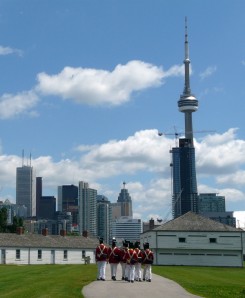 History and archaeology – that’s what attracts me to Fort York and the reason why I put it at the top of my list of “Must See’s” for Toronto. Cocooned by condos, railway lines and expressways, it’s an historical oasis that perfectly showcases the growth of Toronto.
History and archaeology – that’s what attracts me to Fort York and the reason why I put it at the top of my list of “Must See’s” for Toronto. Cocooned by condos, railway lines and expressways, it’s an historical oasis that perfectly showcases the growth of Toronto.
The best way to get a fix on the fort is to first take the glass elevator to the lofty heights of the CN Tower. In fact, the view from the SkyPod is the only way I know to get a real understanding of how the town of York evolved into the City of Toronto. Look west and you can follow the lake shore. Twentieth century landfill reaches almost to the Island Airport but move the eye inland across the Condos and the Gardiner Expressway and you can see where the original shoreline of the lake once straddled the southern boundary of Fort York. That’s it, that little triangle of green with a flag and a few buildings and usually the tiny speck of a uniformed 1812 soldier or two followed by a herd of young school kids all pretending they have muskets on their shoulders and are off to do battle with the Americans.
At ground level, the War of 1812, the life style of the 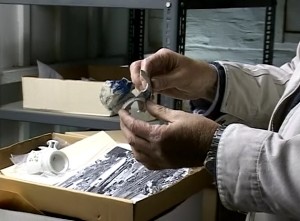 soldiers and the armaments of the day, is the standard introduction most people get to Fort York, but I like to dig a little more. Some years ago, aided and abetted by the Fort’s local archaeologist, David Spittal, the filming of ‘Toronto 175’ gave me the chance to get the dirt on the Fort. David introduced me to the original location of the Lieutenant-Governor’s residence. They had already done some digging and along with the foundations of the house had uncovered pieces of pottery. Seems John Graves Simcoe and subsequent representatives of the Crown had to bring their own crockery when they travelled from Britain to Upper Canada. When the Americans burned the fort a lot of those private possessions were broken and buried in the debris. Armed with this information I paid a visit to the current Lt. Governor of Ontario, David Onley, who is himself a history buff, with a wealth of knowledge about his predecessors and the war between the British and the Americans.
soldiers and the armaments of the day, is the standard introduction most people get to Fort York, but I like to dig a little more. Some years ago, aided and abetted by the Fort’s local archaeologist, David Spittal, the filming of ‘Toronto 175’ gave me the chance to get the dirt on the Fort. David introduced me to the original location of the Lieutenant-Governor’s residence. They had already done some digging and along with the foundations of the house had uncovered pieces of pottery. Seems John Graves Simcoe and subsequent representatives of the Crown had to bring their own crockery when they travelled from Britain to Upper Canada. When the Americans burned the fort a lot of those private possessions were broken and buried in the debris. Armed with this information I paid a visit to the current Lt. Governor of Ontario, David Onley, who is himself a history buff, with a wealth of knowledge about his predecessors and the war between the British and the Americans. 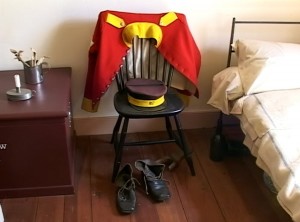 He told me that when John Graves Simcoe arrived at the sheltered harbor on the northern shores of Lake Ontario in 1793 he decided this would be the perfect location for his new capital of Upper Canada and put up a tent – Captain Cook’s tent to be precise – and moved in.
He told me that when John Graves Simcoe arrived at the sheltered harbor on the northern shores of Lake Ontario in 1793 he decided this would be the perfect location for his new capital of Upper Canada and put up a tent – Captain Cook’s tent to be precise – and moved in.
Over time, as the Fort’s location switched variously from one side of the Garrison Creek to the other, a Governor’s residence was built along with log barracks for the soldiers, a Blockhouse, Grand Magazine and an Officers’ Mess. When you consider the War of 1812, the American invasion, and the frequency of fires in the new settlement, it’s remarkable that some of the original buildings survived and that the site contains seven of the eight oldest buildings constructed in the City. Even more remarkable, given the size of the property – 43 acres – and the city’s current predilection for Condo-mania and knocking down anything over 20 years old! It’s only due to people like the Friends of Fort York that we have managed to save an incredible piece of Canada’s history.
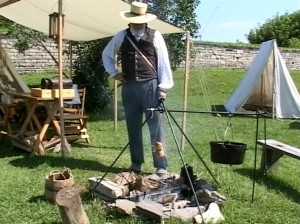 The “Friends” are passionate about the Fort and rarely miss an opportunity to dress up and give a sense of life in the 1800s. Along with historical re-enactments and annual events, I’ve joined them for evenings of dancing in the Junior Officer’s Barracks, watched them bake basil biscuits over an open-hearth fire in the Mess Establishment, and attended Remembrance Day services at Garrison Cemetery honouring First Nations, British and American soldiers, who lost their lives during the 1812 conflict.
The “Friends” are passionate about the Fort and rarely miss an opportunity to dress up and give a sense of life in the 1800s. Along with historical re-enactments and annual events, I’ve joined them for evenings of dancing in the Junior Officer’s Barracks, watched them bake basil biscuits over an open-hearth fire in the Mess Establishment, and attended Remembrance Day services at Garrison Cemetery honouring First Nations, British and American soldiers, who lost their lives during the 1812 conflict.
Built into the basement of the Officer’s Mess, the discovery of two money 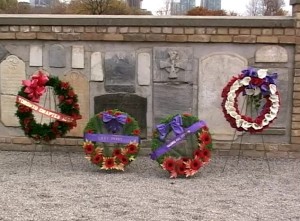 vaults that were used to hide gold and silver bullion during the 1838 Rebellion is just one example of how on-going archaeology is revealing unexpected touchstones to the City’s history. Even the heavy timbers of the Commissioners Wharf built in 1816 and excavated out of the embankment when the Domed Stadium was built, have found a home at Fort York.
vaults that were used to hide gold and silver bullion during the 1838 Rebellion is just one example of how on-going archaeology is revealing unexpected touchstones to the City’s history. Even the heavy timbers of the Commissioners Wharf built in 1816 and excavated out of the embankment when the Domed Stadium was built, have found a home at Fort York.
On my visits I also like to sit with Nature’s little archaeologists, the ground-hogs who have found sanctuary in the earthworks that surround the Fort and who have been known to find treasures from their tunneling exploits. Usually it’s 20th century garbage that was used as landfill and doesn’t relate to the military history of the fort. But, as I look over those ramparts and think back up to that view from the top of the CN Tower, “Go jump in the Lake” has new meaning. 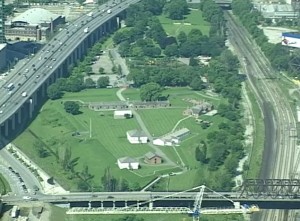 I can visualize the waters of Lake Ontario lapping on the shores just below me and the ships that would have sailed through the mouth of the harbor past the canon of Fort York – new immigrants on board filled with the excited anticipation of starting a new life in a new country. Some things never change.
I can visualize the waters of Lake Ontario lapping on the shores just below me and the ships that would have sailed through the mouth of the harbor past the canon of Fort York – new immigrants on board filled with the excited anticipation of starting a new life in a new country. Some things never change.
Fort York has withstood battles, fires, rebellions, an American invasion, and 20th century progress. Today as it commemorates the Bi-Centennial of the War of 1812 with the building of a new interactive visitor’s centre, Fort York cheerfully welcomes the return of all those elements and remains a vital link to the City’s past.


